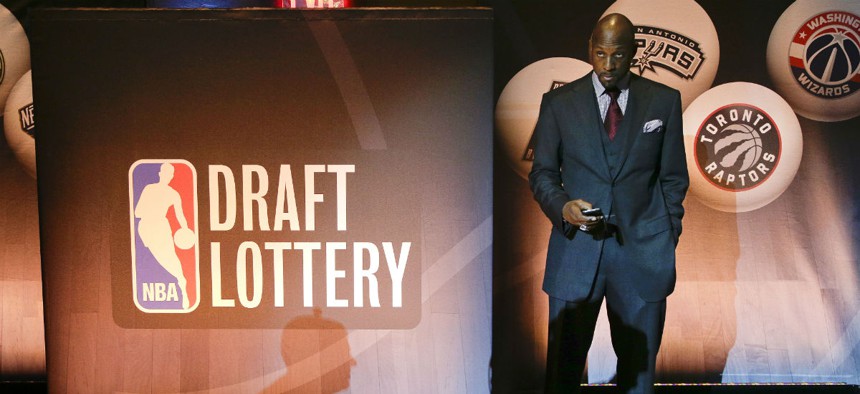
Miami Heat VP Alonzo Mourning checks his cellphone before the NBA draft lottery in May. Julie Jacobson/AP
What Federal Recruiters Can Learn From the NBA Draft
Scouting the best players isn't all that different for government.
This is the time of year when NBA teams take stock of their personnel and figure out how to leverage the talent of the incoming draft class. Ultimately, the draft is about the improvement of teams through the acquisition of new personnel. And, in this sense, federal agencies and pro basketball teams have much in common—especially with regard to the use of analytics for talent management.
For NBA teams, the draft’s value extends beyond looking at the pool of players and determining who has the most talent—it’s about building a championship team. A wide range of issues including team needs/gaps, existing skills pool, future growth and even potential player departures is analyzed to determine the best recruits from the current crop of upcoming players. In many ways, this directly corresponds with what forward-thinking agencies are studying when making talent management decisions.
So with the NBA draft quickly approaching, let’s look at the key considerations of talent acquisition from the perspective of the draft and how that parallels federal hiring.
Building a successful NBA team today requires the use of analytics covering a wide range of metrics. These metrics address potential draftees as well as the existing team’s makeup, competitors’ strengths/weaknesses and the availability of free agents and players in international leagues.
Similarly, federal agencies must assess more than the applicants. They should also consider the makeup of their existing teams, budget allocation and available talent. In particular, both the NBA and agencies will improve their short- and long-term success by embracing analytics and the insight analytics can provide in assembling a winning team.
Talent Acquisition
While talent acquisition may seem like a basic component of the draft, it is much more involved than it appears on the surface. Even if there is the occasional consensus on the top one or two picks, the process becomes blurrier after that. And even for those consensus picks, there’s work—and analysis—to complete before making the selection. NBA teams meet with prospects to assess speed, strength, agility, overall intellect, “basketball IQ,” and character to come up with their top choices.
Similarly, the government’s own version of these measurements—the civil service exam and USA Hire—provides recruiters with insights into candidates’ experience, productivity, vocational intelligence, “team” mentality and growth potential. By analyzing this information, agencies will be much more confident that their hires are a great fit for the organization, while developing a better understanding of a new hire’s leadership potential and probability of remaining with the agency for an extended time.
Performance Management
NBA teams have to look at their existing personnel—who is aging or close to retirement, who is injured, who is likely to leave due to free agency, who will likely leave over the next three to five years—to gauge current and future needs and determine which players to target. Based on this data, even if a player with greater talent is available, it might not make sense to draft the player if he does not fill a critical skills gap for a specific position.
Agencies should use analytics to do the same in filling current and future needs. Analytics can establish a clear understanding of current skills gaps as well as future ones—based upon retirement and retention projections and existing shortfalls in leadership or particular technical skills. Data that provides insight into candidates’ potential is also helpful in determining future success.
Scouting
In addition, teams prep for the draft by developing a sense of where strong talent comes from. This may include metrics such as:
- Which schools produce the best players and at which position.
- Which schools tend to generate players who make a smooth transition to the NBA.
- Which schools produce players who have a long NBA tenure.
Similarly, federal recruiters use analytics to assess which schools have produced the best candidates in the government ranks. This may include not only academic insight, but leadership potential, likelihood to remain with the agency and more.
Every Day Is Draft Day
Drafting players for the NBA is rarely done in a vacuum and it’s rarely done exclusively based on a team’s judgment of a player’s skills. Teams need evaluate a wide range of considerations throughout a spectrum of disciplines. The same holds true for federal agencies in recruiting personnel and in overall talent management. And while it does not garner the attention of the NBA and its draft, with thousands of jobs and careers involved, along with the success of missions, the end result for agencies is even more critical—every day is “draft day.”
Liam Ackland is president of NGA.NET, North America.






